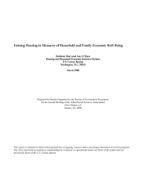
An official website of the United States government
Here’s how you know
Official websites use .gov
A .gov website belongs to an official government organization in the United States.
Secure .gov websites use HTTPS
A lock (
) or https:// means you’ve safely connected to the .gov website. Share sensitive information only on official, secure websites.
-
//
- Census.gov /
- Census Working Papers /
- Valuing Housing in Measures of Household and Family Economic Well-Being
Valuing Housing in Measures of Household and Family Economic Well-Being
Valuing Housing in Measures of Household and Family Economic Well-Being
The most commonly used measures of economic well-being in the United States is household income. This measure is based on money income which is commonly criticized as misrepresenting the well-being of the elderly. Since the money income of elderly families and households is low after retirement, they tend to appear to be less well-off relative to other family types. A common suggestion is to note that elderly families and individuals often own their homes without mortgages and pay below 'market rent' for their homes. In this sense they are ‘better off’ than younger families with high mortgage payments. Including imputed net rental income from owned homes when examining income distributions attempts to address this issue – to find a way to account for the fact that homeowners who have paid down mortgage debt have much lower housing costs than renters or homeowners with mortgages.These concepts figure into deliberations about the proper definitions of income. In 2001, the Canberra Group released a report consistently defining household income for use in distributional measures used by statistical organizations around the world. Some of these definitions address the need to account for home ownership
Share
Some content on this site is available in several different electronic formats. Some of the files may require a plug-in or additional software to view.
 Yes
Yes
 No
NoComments or suggestions?


Top

